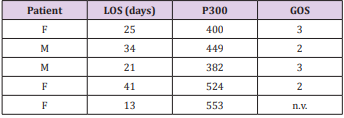Evaluation of Consciousness State in Subjects with Brain Injuries in Intensive Care: Use of the Potential Related Event P300 - Pilot Study
Introduction
Brain damage resulting from traumas or cerebrovascular accidents can lead to serious deficits, including cognitive impairments. The assessment of the state of consciousness in subjects suffering from brain injuries in Intensive Care is therefore important in order to establish the outcome expected in relation to outcomes, including cognitive impairment. Radiological examinations, clinical evaluation and electroencephalograms provide useful but not conclusive information. It is therefore advisable to identify a more accurate tool, which is independent of the subjectivity of the operator and the subject examined. From this perspective, potential related events (ERPs) seem to provide good results. ERPs represent an interface that transduces cognitive functions into related behavioral manifestations. They are the result of the synchronized change of slow post synaptic potentials [1-4].
They appear as waveforms characterized by a sequence of positive or negative monobasic deflections. P300 is an eventrelated potential that reflects the subject’s level of attention relative to an acoustic stimulus. The aim of the work was to test the feasibility of exam in intensive care and its correlation with the rehabilitation outcome. We enrolled 5 patients (3F / 2M, mean age 71,8years, Glasgow Coma Scale <8) admitted to postoperative intensive care at the Sant’Andrea hospital in Rome, Italy, following a severe haemorrhagic insult. All patients had undergone neurosurgical intervention. In intensive care they were mechanically ventilated by tracheotomy performed with modified Ciaglia technique. After 48 hours from surgery the patients underwent electroencephalogram and evaluation of the P300. The examinations were conducted by the same operator, a specialist in neurophysiopathology. The analysis of P300 was conducted by administering to patients a stimulus called odd-ball which consists of providing a randomized sequence of target (rare) and non-target (predominantly) clearly distinguishable acoustic stimuli. Acoustic stimulation was active, exogenous and synchronous. The stimuli had an intensity of 70 dB, amplitude of 2000 Hz (target) or 1000 Hz (non-target) and a duration of 400 ms. The interval between the stimuli was 8 seconds, a threshold value below which the P300 showed a diminished amplitude. The recordings were made using cup electrodes, referred to passive electrodes located at the ear lobes and grounded. During the whole hospitalization patients were monitored according to the standard of our department [5-7].
The EEG reported for all patients a picture of widespread cerebral distress reacting to the nociceptive stimulus. The values of P300, evoked only by the target stimuli, are shown in the table. The average length of stay in intensive care was 26.8 days. One patient died on the 13th day following a new haemorrhagic episode. The P300 of this patient, at 48 hours, was 553ms. Two patients reported P300 ≤ 400ms (382ms and 400ms respectively). These patients were sent on a rehabilitation course with a Glasgow Outcome Scale (GOS) value 3 after 21 and 25 days of intensive care. Two other patients had a longer ICU stay, 41 and 34 days during which they maintained a reduced state of consciousness remaining noncontactable. Their P300 values were 524ms and 449ms. They were sent to long-term care facilities with a GOS 2 value. The subjects examined in our study showed a GOS associated with the value of P300. A value of P300 <400ms was associated with a better outcome while values> 400ms were hesitant in GOS 3 (Table 1).
The obvious limitation of our pilot study is the small number of patients. In our opinion, however, it provides a considerable starting point for the application of a non-invasive and more specific tool of the electroencephalogram relative to the cognitive outcome of subjects suffering from traumatic and non-traumatic cerebral hemorrhage. The P300, in fact, has a latency amplitude dependent on the level of attention of the subject towards a rare stimulus inserted in a series of equal stimuli among them. When the stimuli are not coincident the examined subject turns attentional resources towards them. It therefore provides us with the opportunity to identify early the evolution of the neurological subject. The clinical extension of the P300 determination could allow better allocation and use of therapeutic resources in order to prevent or promptly treat secondary damage.
For more Articles on : https://biomedres01.blogspot.com/



No comments:
Post a Comment
Note: Only a member of this blog may post a comment.